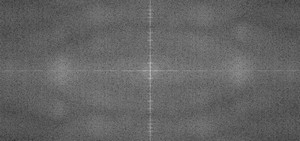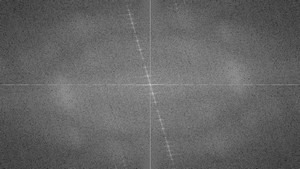OpenCV离散傅里叶变换
目标
我们会为以下问题寻求答案:
- 什么是傅里叶变换,为什么要使用?
- 在OpenCV中怎么做?
- 函数的使用如:cv :: copyMakeBorder(),cv :: merge(),cv :: dft(),cv :: getOptimalDFTSize(),cv :: log()和cv :: normalize()。
源代码
您可以从这里下载,也可以在samples/cpp/tutorial_code/core/discrete_fourier_transform/discrete_fourier_transform.cppOpenCV源代码库中找到它。
以下是cv :: dft()的示例用法:
#include "opencv2/core.hpp"
2 #include "opencv2/imgproc.hpp"
3 #include "opencv2/imgcodecs.hpp"
4 #include "opencv2/highgui.hpp"
5
6 #include <iostream>
7
8 using namespace cv;
9 using namespace std;
10
11 static void help(char* progName)
12 {
13 cout << endl
14 << "This program demonstrated the use of the discrete Fourier transform (DFT). " << endl
15 << "The dft of an image is taken and it's power spectrum is displayed." << endl
16 << "Usage:" << endl
17 << progName << " [image_name -- default ../data/lena.jpg] " << endl << endl;
18 }
19
20 int main(int argc, char ** argv)
21 {
22 help(argv[0]);
23
24 const char* filename = argc >=2 ? argv[1] : "../data/lena.jpg";
25
26 Mat I = imread(filename, IMREAD_GRAYSCALE);
27 if( I.empty())
28 return -1;
29
30 Mat padded; //expand input image to optimal size
31 int m = getOptimalDFTSize( I.rows );
32 int n = getOptimalDFTSize( I.cols ); // on the border add zero values
33 copyMakeBorder(I, padded, 0, m - I.rows, 0, n - I.cols, BORDER_CONSTANT, Scalar::all(0));
34
35 Mat planes[] = {Mat_<float>(padded), Mat::zeros(padded.size(), CV_32F)};
36 Mat complexI;
37 merge(planes, 2, complexI); // Add to the expanded another plane with zeros
38
39 dft(complexI, complexI); // this way the result may fit in the source matrix
40
41 // compute the magnitude and switch to logarithmic scale
42 // => log(1 + sqrt(Re(DFT(I))^2 + Im(DFT(I))^2))
43 split(complexI, planes); // planes[0] = Re(DFT(I), planes[1] = Im(DFT(I))
44 magnitude(planes[0], planes[1], planes[0]);// planes[0] = magnitude
45 Mat magI = planes[0];
46
47 magI += Scalar::all(1); // switch to logarithmic scale
48 log(magI, magI);
49
50 // crop the spectrum, if it has an odd number of rows or columns
51 magI = magI(Rect(0, 0, magI.cols & -2, magI.rows & -2));
52
53 // rearrange the quadrants of Fourier image so that the origin is at the image center
54 int cx = magI.cols/2;
55 int cy = magI.rows/2;
56
57 Mat q0(magI, Rect(0, 0, cx, cy)); // Top-Left - Create a ROI per quadrant
58 Mat q1(magI, Rect(cx, 0, cx, cy)); // Top-Right
59 Mat q2(magI, Rect(0, cy, cx, cy)); // Bottom-Left
60 Mat q3(magI, Rect(cx, cy, cx, cy)); // Bottom-Right
61
62 Mat tmp; // swap quadrants (Top-Left with Bottom-Right)
63 q0.copyTo(tmp);
64 q3.copyTo(q0);
65 tmp.copyTo(q3);
66
67 q1.copyTo(tmp); // swap quadrant (Top-Right with Bottom-Left)
68 q2.copyTo(q1);
69 tmp.copyTo(q2);
70
71 normalize(magI, magI, 0, 1, NORM_MINMAX); // Transform the matrix with float values into a
72 // viewable image form (float between values 0 and 1).
73
74 imshow("Input Image" , I ); // Show the result
75 imshow("spectrum magnitude", magI);
76 waitKey();
77
78 return 0;
79 }说明
傅立叶变换将图像分解为其窦道和余弦分量。换句话说,它会将图像从其空间域转换到其频域。这个想法是任何函数可以用无限窦和余弦函数的和来精确地近似。傅立叶变换是一种如何做到这一点的方法。数学上二维图像傅立叶变换是:

这里f是其空间域中的图像值,在其频域中是F。转换的结果是复数。可以通过实际图像和复杂图像或通过幅度和相位图像来显示这一点。然而,在整个图像处理算法中,只有幅面图像很有趣,因为它包含了我们所需要的关于图像几何结构的所有信息。然而,如果您打算以这些形式对图像进行一些修改,那么您需要重新转换它,您将需要保留这两种形式。
在本例中,我将展示如何计算和显示傅立叶变换的幅度图像。在数字图像是离散的情况下。这意味着它们可以占用给定域值的值。例如,在基本的灰度图像中,值通常在0和255之间。因此,傅里叶变换也需要是离散傅里叶变换,导致离散傅里叶变换(DFT)。当您需要从几何角度确定图像的结构时,您将需要使用它。以下是要遵循的步骤(在灰度输入图像I的情况下):
- 将图像展开至最佳尺寸。DFT的性能取决于图像大小。对于数字二,三和五的倍数,图像尺寸趋向于最快。因此,为了获得最大的性能,通常最好将边框值填充到图像以获得具有这种特征的大小。该品种:: getOptimalDFTSize()返回这个最佳规模,我们可以使用CV :: copyMakeBorder()函数来扩大图像的边界:
Mat padded; //expand input image to optimal size
int m = getOptimalDFTSize( I.rows );
int n = getOptimalDFTSize( I.cols ); // on the border add zero pixels
copyMakeBorder(I, padded, 0, m - I.rows, 0, n - I.cols, BORDER_CONSTANT, Scalar::all(0));附加的像素被初始化为零。
- 为复杂和真实的价值取得成就。傅里叶变换的结果是复杂的。这意味着对于每个图像值,结果是两个图像值(每个分量一个)。此外,频域范围远远大于其空间对应物。因此,我们通常至少以浮动格式存储它们。因此,我们将把我们的输入图像转换为这种类型,并用另一个通道来展开,以保持复杂的值:
Mat planes[] = {Mat_<float>(padded), Mat::zeros(padded.size(), CV_32F)};
Mat complexI;
merge(planes, 2, complexI); // Add to the expanded another plane with zeros- 进行离散傅里叶变换。可能的就地计算(与输出相同的输入):
dft(complexI, complexI); // this way the result may fit in the source matrix
- 将真实和复杂的值转化为大小。复数具有真实(Re)和复数(虚数Im)部分。DFT的结果是复数。DFT的大小是:

翻译为OpenCV代码:
split(complexI, planes); // planes[0] = Re(DFT(I), planes[1] = Im(DFT(I))
magnitude(planes[0], planes[1], planes[0]);// planes[0] = magnitude
Mat magI = planes[0];- 切换到对数刻度。原来,傅里叶系数的动态范围太大,无法显示在屏幕上。我们有一些小而高的变化值,我们不能这样观察。因此,高价值将全部作为白点,而小的则为黑色。为了将灰度值用于可视化,我们可以将我们的线性比例变换为对数:

翻译为OpenCV代码:
magI += Scalar::all(1); // switch to logarithmic scale
log(magI, magI);- 作物和重新排列。记住,在第一步,我们扩大了形象?那么现在是摒弃新推出的价值观的时候了。为了可视化的目的,我们还可以重新排列结果的象限,使原点(零,零)对应于图像中心。
magI = magI(Rect(0, 0, magI.cols & -2, magI.rows & -2));
int cx = magI.cols/2;
int cy = magI.rows/2;
Mat q0(magI, Rect(0, 0, cx, cy)); // Top-Left - Create a ROI per quadrant
Mat q1(magI, Rect(cx, 0, cx, cy)); // Top-Right
Mat q2(magI, Rect(0, cy, cx, cy)); // Bottom-Left
Mat q3(magI, Rect(cx, cy, cx, cy)); // Bottom-Right
Mat tmp; // swap quadrants (Top-Left with Bottom-Right)
q0.copyTo(tmp);
q3.copyTo(q0);
tmp.copyTo(q3);
q1.copyTo(tmp); // swap quadrant (Top-Right with Bottom-Left)
q2.copyTo(q1);
tmp.copyTo(q2);- 规范化。这再次为可视化目的而完成。我们现在有这样的大小,但是这仍然是我们的图像显示范围从零到一。我们使用cv :: normalize()函数将值归一化到此范围。
normalize(magI, magI, 0, 1, NORM_MINMAX); // Transform the matrix with float values into a
// viewable image form (float between values 0 and 1).
结果
应用程序的想法将是确定图像中存在的几何取向。例如,让我们来看一下文本是否是横向的?看一些文字你会注意到,文本行的形式也是水平线,字母形成垂直线。在傅里叶变换的情况下,也可以看到文本片段的这两个主要组成部分。让我们使用这个水平和这个旋转的图像关于一个文本。
在水平文本的情况下:

在旋转文本的情况下:

您可以看到频域中最有影响力的组件(幅度图像上最亮点)遵循图像上对象的几何旋转。由此,我们可以计算偏移量并执行图像旋转以纠正最终的错误对准。

 免费AI编程助手
免费AI编程助手



更多建议: